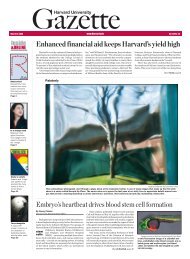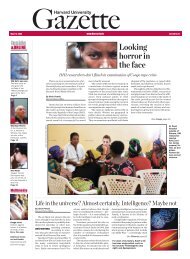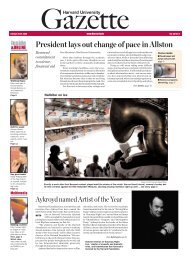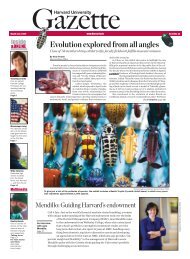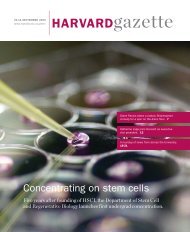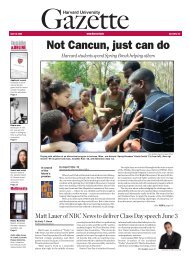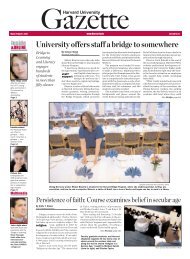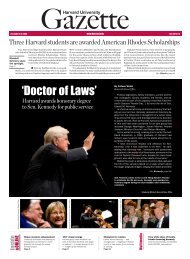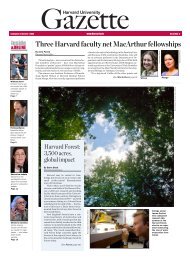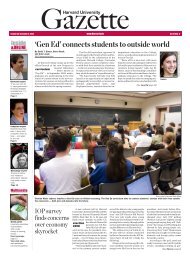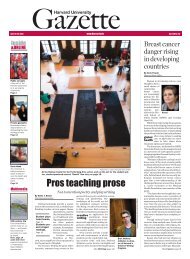4 / <strong>Harvard</strong> University Gazette Oc<strong>to</strong>ber 9-15, 2008Miles named HGSE senior associate dean for DevelopmentLynn Miles will become the <strong>Harvard</strong> GraduateSchool of Education (HGSE) senior associatedean for Development and Alumni Relations,effective Oct. 1.APPOINTMENT As former assistantvice presidentfor resources, direc<strong>to</strong>r of the Leadership GiftProgram, and most recently, acting vice presidentfor resources at Wellesley College, Miles’distinguished career in development includesplaying a key role in designing and executing ahighly successful campaign that raised $472.3million — a record for liberal arts colleges.“We are fortunate <strong>to</strong> have recruited someoneof Lynn’s caliber <strong>to</strong> lead our strong teamin Development and Alumni Relations,which will play an integral role in our excitingplans for the School’s future,” said HGSEdean and Gerald S. Lesser Professor in EarlyChildhood Development Kathleen McCartney.“Lynn’s colleagues have praised hermanagement and leadership style as well asher fundraising expertise, particularly in thearea of campaign planning and execution. Ihave been struck by her intellect, her warmth,and her quick ability <strong>to</strong> understand the mission,goals, and dreams of HGSE. I am lookingforward <strong>to</strong> working with her <strong>to</strong> turn ourvision in<strong>to</strong> reality.”At the School, Miles will oversee majorgifts, alumni relations, development, informationservices, the annual fund, and all developmentcommunications. Previously,Miles has also worked as direc<strong>to</strong>r of majorgifts for New England Medical Center and asdirec<strong>to</strong>r of development for the Floating Hospitalfor Children at Tufts Medical Center. Sheearned her B.A. in psychology from the Universityof Michigan and a professional designationin public relations from UCLA.Spend an ‘Evening withChampions’ Oct. 10-11Top world skaters will skate for a cause this weekend(Oct. 10-11) when they gather at Bright Hockey Centerfor the Jimmy Fund’s annual “An Evening withChampions.” Hosted by 1992 Olympic silver medalistPaul Wylie ’90, the event has raised more than $2.4 millionfor the Jimmy Fund, which supports adult and pediatriccancer research and care at the Dana-FarberCancer Institute.Participating skaters include 2007 World ChampionMiki Ando, 1964 Olympic gold medalists Ludmilla andOleg Pro<strong>to</strong>popov, and national synchronized skatingchampions the Haydenettes, among others.“An Evening with Champions” was started in 1970 byformer U.S. champion John Misha Petkevich, and sincethen has been run entirely by <strong>Harvard</strong> University students.The performances will start on Friday (Oct. 10) at 8p.m. and on Saturday (Oct. 11) at 7 p.m. On Saturday afternoonpediatric cancer patients from the Jimmy FundClinic will have an opportunity <strong>to</strong> skate with performers,and a silent auction held before the show thatevening will include Patriots tickets, hotel stays in NewYork City, and a prize drawing.Tickets are $32 (adults), $12 (children and senior citizens),and $8 (college undergraduates). Group rates arealso available for groups of 10 or more. Tickets can be purchasedthrough the <strong>Harvard</strong> Box Office, (617) 496-2222.For more information, visit www.jimmyfund.org/skating.Twenty-six doc<strong>to</strong>ral candidates will be supportedby the Weatherhead Center for InternationalAffairs for the 2008-09 year. The associatescome from a multidisciplinary groupof advanced-degree candidates in the GraduateSchool of Arts and Sciences’ departmentsof Anthropology, Economics, Government,His<strong>to</strong>ry, Health Policy, Middle EastStudies, Social Policy, and Sociology. All ofthe students are working on dissertationsrelated <strong>to</strong> international affairs.The center provides the associates withoffice space, computer resources, and researchgrants, and they participate in a varietyof seminars, including their own graduatestudent seminar during which they presenttheir work and receive feedback.The center has also granted dissertationcompletion fellowships <strong>to</strong> two associates for2008-09, Yevgeniy Kirpichevsky and GiacomoPonzet<strong>to</strong>, as well as Nico Slate, a Ph.D.candidate in His<strong>to</strong>ry.Honoring a colleagueNick Welles/<strong>Harvard</strong> <strong>News</strong> OfficeDavid L. Hemp<strong>to</strong>n (right), Alonzo L. McDonald Family Professor of Evangelical Theological Studies at <strong>Harvard</strong>Divinity School, delivered the keynote address Oct. 3 at the School’s two-day ‘Conference on AmericanReligious His<strong>to</strong>ry,’ which honored the career of David D. Hall (left), Bartlett Research Professor of NewEngland Church His<strong>to</strong>ry.Weatherhead Center introduces 26 doc<strong>to</strong>ral candidates for 2008-09The 2008-09 Graduate Student Associatesand their research projects, are as follows:Marcus Alexander, Ph.D. candidate, Departmen<strong>to</strong>f Government: Behavioral politicaleconomy; experimental social science;econometrics; dynamics of conflict and cooperation.Chris<strong>to</strong>pher Bail, Ph.D. candidate, Departmen<strong>to</strong>f Sociology: Diverse Diversities:The Configuration of Symbolic BoundariesAgainst Immigrants in 23 European Countries.Suzanna Chapman, Ph.D. candidate, Departmen<strong>to</strong>f Government: Measuring and explainingtrends in restrictive immigration policyin wealthy democracies (1960-2006).Alex Fattal, Ph.D. candidate, Departmen<strong>to</strong>f Anthropology: Demilitarization, demobilization,and reintegration of insurgents inColombia.Garner Gollatz, Ph.D. candidate, Departmen<strong>to</strong>f Anthropology: Healing, pilgrimage,and spirituality at the Sanctuary of Lourdes,France.Karen Grépin, Ph.D. candidate, Departmen<strong>to</strong>f Health Policy: Economics of healthsystems; health human resources; and effectivenessof health development assistance.Research area: Africa, specificallyGhana.Zongze Hu, Ph.D. candidate, Departmen<strong>to</strong>f Anthropology: How locals have encounteredand seen the national state in a NorthChina village.Robert Karl,Ph.D. candidate,Departmen<strong>to</strong>f His<strong>to</strong>ry: State formation, politics, violence,and U.S. influence in 20th century Colombia.Yevgeniy Kirpichevsky, Ph.D. candidate,Department of Government: Secret weaponsand secret diplomacy in international relations.Ian Klaus, Ph.D. candidate, Departmen<strong>to</strong>f His<strong>to</strong>ry: The role of trust in the businessand military relations of the British Empire.Diana Kudayarova, Ph.D. candidate, Departmen<strong>to</strong>f His<strong>to</strong>ry: Labor policy and labormarket strategies of white-collar professionalsin the Soviet Union.Rebecca Nelson, Ph.D. candidate, Departmen<strong>to</strong>f Government: Explaining variationin the terms of sovereign debt restructuringswith private credi<strong>to</strong>rs in the post-World War II era.Vernie Oliveiro, Ph.D. candidate, Departmen<strong>to</strong>f His<strong>to</strong>ry: The United States’ effortsagainst the bribery of foreign public officialsby multinational corporations wishing <strong>to</strong> dobusiness abroad (1975-1997).Sabrina Peri, Ph.D. candidate, Departmen<strong>to</strong>f Social Anthropology: Examining intersectionsof violence, identity, and primaryresource extraction in Bosnia and Herzegovina’sethnographic present, and in its his<strong>to</strong>ry.Sanjay Pin<strong>to</strong>, Ph.D. candidate, Departmen<strong>to</strong>f Sociology and Social Policy: The politicaleconomy of social stratification: Varietiesof occupational structure in post-industrialand newly industrialized societies.Giacomo Ponzet<strong>to</strong>, Ph.D. candidate, Departmen<strong>to</strong>f Economics: The role of partisanshipand voters’ asymmetric informationin the political economy of trade policy.Brenna Powell, Ph.D. candidate, Departmen<strong>to</strong>f Government and Social Policy: Comparativeethno-racial politics, civil conflict,and political violence; dissertation work inNorthern Ireland, Brazil, and the UnitedStates.Jonathan Renshon, Ph.D. candidate, Departmen<strong>to</strong>f Government: How status considerationsaffect the calculations of statesin international politics.Meg Rithmire, Ph.D. candidate, Departmen<strong>to</strong>f Government: Building modern cities:Development, space, and power in urbanChina.Claire Schwartz, Ph.D. candidate, Departmen<strong>to</strong>f Government: Implications of theshift from state governance <strong>to</strong>ward “civil governance”in industrial regulation and the differentialeffects of developed and developingcountries.Sarah Shehabuddin, Ph.D. candidate, Departmen<strong>to</strong>f Government: The rules of engagement:Women’s rights and the determinantsof secularist-Islamist relations.Anthony Shenoda, Ph.D. candidate, Departmen<strong>to</strong>f Anthropology and Middle EastStudies: Coptic Orthodox Christian encounterswith the Miraculous in Egypt.Anya Vodopyanov, Ph.D. candidate, Departmen<strong>to</strong>f Government: Political economyof service provision in the Middle East: Impac<strong>to</strong>f increased basic service provision byIslamic groups on the quality and reach ofgovernment services.Ann Marie Wilson, Ph.D. candidate, Departmen<strong>to</strong>f His<strong>to</strong>ry: An investigation in<strong>to</strong> theorigins of modern American human rights activism,focusing on the Anglo-American humanitarianmovements that arose in response<strong>to</strong> crises in Armenia, Russia, and theCongo Free State between 1880 and 1920.Lili Zhang, Ph.D. candidate, Departmen<strong>to</strong>f Government: Reputation and War Termination:An approach based on psychologyand behavioral economics.Min Zhou, Ph.D. candidate, Departmen<strong>to</strong>f Sociology: Grassroots organizations in the2005 anti-Japan movement in China.
By David CameronHMS CommunicationsResearchers at <strong>Harvard</strong> Medical School and theUniversity of Wisconsin, Madison, have discoveredhow beetles and bacteria form a symbiotic and mutualisticrelationship — one that ultimately results inthe destruction of pine forests. In addition,they’ve identified the specificmolecule that drives this whole phenomenon.The findings, published in the Oct. 3 issue of Science,indicate that the tiny creatures — responsiblefor rampant and widespread forest destruction —carry on their backs battling species of fungi, plus apowerful antibiotic molecule that can destroy pathogenicfungi — something that no current medicationshave achieved.Pathogenic fungal infections are a significant clinicalchallenge. These findings suggest a potential newsource of pharmaceuticals for that purpose. In addition,this study shows how the symbiotic relationshipsbetween plants, animals, and microbes are essentialfor the diversification of life and evolution oforganisms.The context of this discovery can easily be imaginedas a s<strong>to</strong>ry arc that includes some of the most unlikelycharacters and props.Setting: The interior of a pine tree.Enter the protagonist: The pine beetle, boring itsway through the bark, a 5 millimeter arthropod ready<strong>to</strong> go in<strong>to</strong> labor and lay a few hundred eggs. Tucked ina specialized s<strong>to</strong>rage compartment in its shell, theOc<strong>to</strong>ber 9-15, 2008 <strong>Harvard</strong> University Gazette/ 5The pine beetle’s tale: Destructive insect has pharmaceutical potentialsciencebeetle has a ready supply of spores for En<strong>to</strong>mocorticium,a nourishing fungal babyfood for the beetle’s gestating larvae.Enter the antagonist: The mite, a microscopicinterloper that secretly hitcheda ride on the beetle.Conflict: Unbeknownst <strong>to</strong> mother pinebeetle, the mite has snuck in a supply ofOphios<strong>to</strong>ma minus, a pathogenic fungi thatcan wipe out the entire supply of fungal larvaefood. The mite releases this <strong>to</strong>xin.Climax: Will the baby beetles die of starvation?Resolution: Catching the mite off guard — as wellas the scientists conducting the study! — the motherbeetle is ready with actinomycetes, a bacteria that(See Beetle, next page)By Todd DatzHSPH CommunicationsImage courtesy of Clardy LabThe tree-destroyingpine beetle in flight.Smoking, burningsolid fuels inhomes in Chinaprojected <strong>to</strong> causemillions of deathsGiving faculty a leg up the ladder<strong>Harvard</strong> University is launching a newinitiative for ladder faculty designed <strong>to</strong> helpprofessors meet their family caregivingneeds while succeeding throughout theiracademic careers.Assistant and associate professors mustachieve miles<strong>to</strong>nes within a limited timeframe, one that can overlap significantlywith childbearing years. And once they’reawarded tenure, the demands on full professors’time only increase. Balancing thiswith the extremely high cost of quality childcare in the Bos<strong>to</strong>n area can lead <strong>to</strong> hardchoices, including whether <strong>to</strong> stay on an academicpath, <strong>to</strong> leave the region in search ofPho<strong>to</strong> courtesy of Work/Life Resources @ <strong>Harvard</strong>A new program, nicknamed Ladder ACCESS, will provide significant financial assistance<strong>to</strong> income-eligible ladder faculty with very young children.New initiative designed <strong>to</strong> help professors meet family needs without sacrificing advancementa less expensive environment, or <strong>to</strong> delay orforego childbearing.“<strong>Harvard</strong>’s mission of learning, teaching,and research relies on our ability <strong>to</strong> attractthe best scholars <strong>to</strong> our campus,” said PresidentDrew Faust. “Investing in this initiativemeans keeping the academy open <strong>to</strong>parents, which is one of many routes <strong>to</strong> increaseddiversity in academia.”The program, nicknamed Ladder AC-CESS (Access <strong>to</strong> Child Care Excellence, Services,and Support), will make significant financialassistance <strong>to</strong> income-eligible ladderfaculty with very young children. “We knowthat young scholars weigh quality-of-life issuesalong with professional opportunitywhen considering an appointment,” said JudithD. Singer, senior vice provost for FacultyDevelopment and Diversity and JamesBryant Conant Professor of Education.“Among faculty, those who are parents canbe disproportionately burdened by the cos<strong>to</strong>f child care in this region. We need <strong>to</strong> makesure this is not a deciding fac<strong>to</strong>r when facultyare offered appointments at <strong>Harvard</strong> oran impediment <strong>to</strong> a faculty member’s successin meeting the demands inherent in achallenging academic career.”(See Ladder, next page)If current levels of smoking and ofburning biomass and coal fuel in homescontinues in China, researchers estimatethat between 2003 and 2033, 65 milliondeaths will be attributed <strong>to</strong> chronic obstructivepulmonarydisease (COPD) and18 million deaths <strong>to</strong> lung cancer, accountingfor 19 percent and 5 percent ofall deaths in that country during this period,respectively.Researchers at the <strong>Harvard</strong> School ofhealthPublic Health (HSPH) predictthat the combined effectsof these two major fac<strong>to</strong>rs alone willbe responsible for more than 80 percen<strong>to</strong>f COPD deaths and 75 percent of lungcancer deaths in China over a 30-year period.But interventions <strong>to</strong> reduce smokingand household use of biomass fuelsand coal for cooking and heating couldsignificantly reduce the number ofdeaths.The findings are from a study that willappear in the Oct. 25 print issue of theBritish medical journal The Lancet. It isthe first quantitative analysis <strong>to</strong> look atthe combined effects of smoking andhousehold fuel use on COPD, lung cancer,and tuberculosis (TB).Respira<strong>to</strong>ry diseases are among the 10leading causes of deaths in China. Abouthalf of Chinese men smoke, and in morethan 70 percent of homes in China residentscook and heat with wood, coal, andcrop residues. Smoking and pollutionfrom indoor burning of these fuels aremajor risk fac<strong>to</strong>rs for COPD and lungcancer and have been linked with tuberculosis.Globally, more than 900 millionof the world’s 1.1 billion smokers currentlylive in low- and middle-incomecountries, and about one-half of theworld’s population uses biomass fuelsand coal for household energy.Drawing from data on smoking, fueluse, and current as well as projected levelsof COPD, lung cancer, and TB, the authorsset out <strong>to</strong> estimate the effects ofmodifying smoking and fuel use on futureCOPD and lung cancer deaths and TB incidence.They grouped the results in<strong>to</strong>scenarios based on whether interven-(See Smoke, next page)



